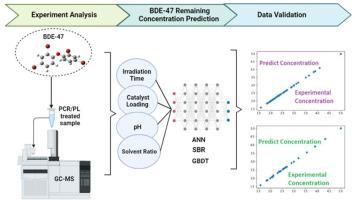Chemosphere ( IF 8.1 ) Pub Date : 2023-03-10 , DOI: 10.1016/j.chemosphere.2023.138363 Mahsa Motamedi 1 , Laleh Yerushalmi 1 , Fariborz Haghighat 1 , Zhi Chen 1 , Yanbin Zhuang 1

|
Polybrominated diphenyl ethers (PBDEs) are halogenated organic compounds that are among the major pollutants of water, and there is an urgent need for their removal. This work compared the application of two techniques, i.e., photocatalytic reaction (PCR) and photolysis (PL), for 2,2,4,4- tetrabromodiphenyl ether (BDE-47) degradation. Although a limited degradation of BDE-47 was observed by photolysis (LED/N2), photocatalytic oxidation by using TiO2/LED/N2 proved to be effective in the degradation of BDE-47. The use of a photocatalyst enhanced the extent of BDE-47 degradation by around 10% at optimum conditions in anaerobic systems. Experimental results were systematically validated through modeling with three new and powerful Machine Learning (ML) approaches, including Gradient Boosted Decision Tree (GBDT), Artificial Neural Network (ANN), and Symbolic Regression (SBR). Four statistical criteria (Coefficient of Determination (R2), Root Mean Square Error (RMSE), Average Relative Error (ARER), and Absolute Error (ABER)) were calculated for model validation. Among the applied models, the developed GBDT was the desirable model for predicting the remaining concentration (Ce) of BDE-47 for both processes. Total Organic Carbon (TOC) and Chemical Oxygen Demand (COD) results confirmed that BDE-47 mineralization required additional time than its degradation in both PCR and PL systems. The kinetic study demonstrated that BDE-47 degradation for both processes followed the pseudo-first-order form of the Langmuir-Hinshelwood (L-H) model. More importantly, the calculated electrical energy consumption of photolysis was shown to be ten percent higher than that for photocatalysis, possibly due to the higher irradiation time required in direct photolysis, which in turn increases electricity consumption. This study is useful in proposing a feasible and promising treatment process for the degradation of BDE-47.
中文翻译:

2,2,4,4-四溴二苯醚 (BDE-47) 的光催化和光解比较:使用三种现代机器学习模型的操作参数、动力学研究和数据验证
多溴二苯醚 (PBDEs) 是卤代有机化合物,是水体的主要污染物之一,迫切需要去除它们。这项工作比较了两种技术(即光催化反应 (PCR) 和光解 (PL))在 2,2,4,4-四溴二苯醚 (BDE-47) 降解中的应用。尽管通过光解 (LED/N 2 )观察到 BDE-47 的降解有限,但使用 TiO 2 /LED/N 2进行光催化氧化证明对 BDE-47 的降解有效。在厌氧系统的最佳条件下,光催化剂的使用使 BDE-47 的降解程度提高了约 10%。通过使用三种新的强大的机器学习 (ML) 方法建模,系统地验证了实验结果,包括梯度提升决策树 (GBDT)、人工神经网络 (ANN) 和符号回归 (SBR)。四个统计标准(决定系数(R 2)、均方根误差 (RMSE)、平均相对误差 (ARER) 和绝对误差 (ABER))用于模型验证。在应用的模型中,开发的 GBDT 是预测两个过程中 BDE-47 剩余浓度 (Ce) 的理想模型。总有机碳 (TOC) 和化学需氧量 (COD) 结果证实,BDE-47 矿化需要比 PCR 和 PL 系统中的降解更多的时间。动力学研究表明,这两个过程的 BDE-47 降解都遵循 Langmuir-Hinshelwood (LH) 模型的准一级形式。更重要的是,计算出的光解电能消耗比光催化高 10%,这可能是由于直接光解需要更长的照射时间,这反过来又增加了电力消耗。本研究有助于提出可行且有前景的 BDE-47 降解处理工艺。














































 京公网安备 11010802027423号
京公网安备 11010802027423号